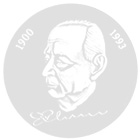For the development of MRI diffusion tensor imaging, which is used for surgery and radiation planning, research into neurological diseases associated with white matter changes, and reconstruction of neural pathways in the brain (tractography)
Magnetic resonance imaging (MRI) is an imaging technique for generating cross-sectional images of the human body based on the measurement of the magnetization of certain atomic nuclei (usually hydrogen nuclei) by means of excitation by radiofrequency pulses within a strong magnetic field. The method thus does not require X-rays. While magnetic resonance spectroscopy had been known in chemistry for some time, MRI as an imaging method was invented in 1971 by the American chemist Paul C. Lauterbur. Beginning in 1974, the British physicist Sir Peter Mansfield developed the necessary mathematical methods to convert the relaxation signals of atomic nuclei into image information. In 2003, Paul Christian Lauterbur and Peter Mansfield were awarded the Nobel Prize in Physiology or Medicine for the development of magnetic resonance imaging.
Diffusion tensor imaging (DTI) is a diffusion MRI method in which the molecular diffusion motion of water molecules in particular can be spatially imaged using special MRI sequences. Since the diffusion of water molecules within cells (e.g. along the axons of nerve cells) is less impeded than across membrane boundaries, this method can be used to visualize nerve tracts in the brain (so-called “tractography”). Diffusion MRI was developed in the 1980s and is based on preliminary work by the chemists Stejskal and Tanner in the 1960s, who used fast switching magnetic gradient fields to measure the diffusion of hydrogen nuclei in nuclear magnetic resonance experiments. In 1985, the French neuroradiologist and physicist and ERS technology awardee Denis Le Bihan introduced this diffusion measurement concept to magnetic resonance imaging. Together with the American engineer and ERS technology laureate Peter J. Basser, Le Bihan then introduced the diffusion tensor method in 1994, which allows the directional dependence of diffusion coefficients to be quantified.
Diffusion tensor imaging has become widely used in radiology and has been adopted by all relevant MRI equipment manufacturers in their respective tomographs. Clinically, it is used for e.g. stroke diagnosis and surgical planning, oncology as well as in research. The DTI method remains the only imaging technique available for in vivo imaging of nerve fibers.
